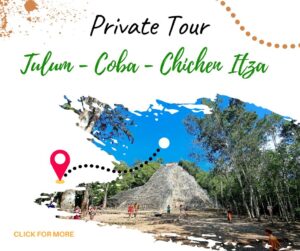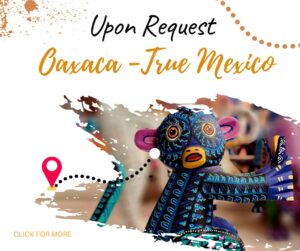
TRAVEL IN TIME – ACIENT, COLONIAL & MODERN MEXICO
Chichen Itza is one of the most visited archaeological sites in Mexico. This pre-Columbian city built by the Maya was named a UNESCO World Heritage Site in 1988. In 2007 a massive step pyramid, known as El Castillo or Temple of Kukulcan which dominates the ancient Mayan city of Chichen Itza was named one of the New Seven Wonders of the World.
Until the beginning of the 20th century, Valladolid was the third largest and most important city of the Yucatán Peninsula, after Mérida and Campeche. The city is deeply Mayan. Many women wear the traditional Mayan huipil — white cotton blouses or dresses adorned with bright, flowered embroidery and sold in places like the Mercado de Artesanias located across the city’s beautiful, newly refurbished Parque Principal.
Ikkil – one of the most beautiful cenotes in Yucatan. A natural freshwater pool of almost perfect circular shape of 60 meters. The height of the cenote is 27 meters and the water is 50 meters deep. The cenote is surrounded by a beautiful tropical garden which is home to a number of different species of birds. Spider monkeys also live in the area.

MAYAN MYSTERIES
Walled Mayan city of Tulum served as a major port for Coba. Jade, obsidian, ceramics, incense burners, gold and copper objects, salt and textiles were among some of the goods brought by traders to Tulum by sea that would be dispersed inland. The ruins are situated on 12-meter tall cliffs, inside the Tulum National Park overlooking one of the most beautiful beaches in the Caribbean.
Cobá was one of the most important Maya cities in the Yucatan Peninsula. The city is hidden in the heart of the jungle. Visitors can enjoy the shaded paths of the sacbeos (white roads), three settlements, 2 pelota courts and admire the tallest (42m) Mayan pyramid in the Yucatan, Nohoch Mul. The archaeological site contains numerous steles (free-standing, carved stone slabs) that document the rites and important events in the city.
We start the trip with a visit to the ancient Mayan port of Tulum – a city built on a cliff in a breathtaking scenery.

CENOTE SUYTUN, LAS COLORADAS & RIO LAGARTOS
Cenote Suytun is a semi-open cenote: its swimming hole is located underground and there is a small opening in the roof which allows light and air to flow in. It is the viewing platform that makes Cenote Suytun unique. A narrow stone walkway leads to a circular platform that sits directly under the opening in its roof –
standing on the platform when the light beams are directly overhead.
Río Lagartos (Alligator River) is a fishing village populated by crocodiles, flamingos (and Mexicans). A paradise for all nature lovers, Río Lagartos is home to a great diversity of flora and fauna: 400 species of birds including pelicans, frigates, ospreys, herons, 100 species of fish, about 105 species of reptiles and 57 of mammals.
Neighbouring village Las Coloradas is famous for pink waters of the nearby salt mines.

SIAN KA’AN UNESCO HERITAGE BIOSPHERE RESERVE
Sian Ka´an is one of Mexico’s largest protected areas, established to manage 528,148 hectares of intricately linked marine, coastal and terrestrial ecosystems. In the language of the Mayans Sian Ka’an means ‘Gate to Heaven’.
The biosphere reserve contains tropical forests, mangroves and marshes, as well as a large marine section intersected by a barrier reef. It provides a habitat for a remarkably rich flora and a fauna comprising more than 300 species of birds, as well as a large number of the region’s characteristic terrestrial vertebrates, which cohabit in the diverse environment formed by its complex hydrological system.
The diversity of life in Sian Ka’an is exceptional. The tropical forests are home to charismatic mammals such as jaguar, puma, ocelot and central american tapir. The property also provides habitat for a large number of resident and migratory bird species. There is a great diversity of marine life, including the west indian manatee, four species of nesting marine turtles and hundreds of fish species.

HOLBOX
Holbox an oasis of peace and tranquility is a part of the Yum Balam Nature Reserve. It is separated from the mainland by the Yalahau Lagoon, which is home to flamingos and pelicans.
Most of the people of Holbox Island make their living fishing. The streets of Holbox Island are made of white sand, common of Caribbean islands, and there are very few cars. Electricity reached the island in 1987, and even now, visitors should expect spotty cell and WiFi signals. Google Maps doesn’t recognize the sandy pathways that function as informal streets.
Holbox is a great destination for street art. Many homes are painted in bright colors, and it’s not unusual for local businesses to hand-paint signs or decor for their restaurants and shops.

3 IN 1: TULUM – COBA – CHICHEN ITZA
Walled Mayan city served as a major port for Coba. Jade, obsidian, ceramics, incense burners, gold and copper objects, salt and textiles were among some of the goods brought by traders to Tulum by sea that would be dispersed inland. The ruins are situated on 12-meter tall cliffs, inside the Tulum National Park overlooking one of the most beautiful beaches in the Caribbean.
Cobá was one of the most important Maya cities in the Yucatan Peninsula. The city is hidden in the heart of the jungle. Visitors can enjoy the shaded paths of the sacbeos (white roads), three settlements, 2 pelota courts and admire the tallest (42m) Mayan pyramid in the Yucatan, Nohoch Mul. The archaeological site contains numerous steles (free-standing, carved stone slabs) that document the rites and important events in the city.
Chichen Itza is one of the most visited archaeological sites in Mexico. This pre-Columbian city built by the Maya was named a UNESCO World Heritage Site in 1988. In 2007 a massive step pyramid, known as El Castillo or Temple of Kukulcan which dominates the ancient Mayan city of Chichen Itza was named one of the New Seven Wonders of the World.
Ikkil – one of the most beautiful cenotes in Yucatan. A natural freshwater pool of almost perfect circular shape of 60 meters. The height of the cenote is 27 meters and the water is 50 meters deep. The cenote is surrounded by a beautiful tropical garden which is home to a number of different species of birds. Spider monkeys also live in the area.

EK BALAM – COBA – TULUM
Ek Balam is an unique, interesting and lesser-known Mayan Ruins site with impressive structures that is surrounded by dense jungle. In Maya language The word Ek Balam means “black jaguar”. The city is composed of several temples, two palaces and a large pyramid (El Torre) which is located in the center. Buildings were designed in the northern Petén architectural style.
Cobá was one of the most important Mayan cities on the Yucatan Peninsula. The city is hidden in the heart of the jungle. Visitors can enjoy shaded walkways that are the original sacbeos (white roads), three settlements that show the architecture of this once large city, 2 ball courts and admire the highest (42m) Mayan pyramid in the Yucatan, Nohoch Mul. The archeological site contains numerous stelae (free-standing carved stone slabs), that document ceremonial life and important events of the city.
Walled Mayan city served as a major port for Coba. Jade, obsidian, ceramics, incense burners, gold and copper objects, salt and textiles were among some of the goods brought by traders to Tulum by sea that would be dispersed inland. The ruins are situated on 12-meter tall cliffs, inside the Tulum National Park overlooking one of the most beautiful beaches in the Caribbean.

Upon Request: MAGICAL CHIAPAS
In Chiapas, Maya cities are concentrated along the state borders with Tabasco and Guatemala. Most of this area belongs to the Lacando jungle.
In one of the most beautiful archaeological zones in Mexico in Palenque, you can find unique architecture, sculptures and bas-reliefs created by the Mayans. The most famous ruler of Palenque was K’inich Janaab Pakal, or Pacal the Great, whose tomb was found in the Temple of Inscriptions. It is estimated that less than 10% of the city’s total area has been explored, leaving over a thousand structures still covered in jungle.
The most important craft in Chiapas is the manufacture of textiles, most of which are linen woven on a loom. Girls often learn to sew and embroider before they can speak Spanish. They also learn how to make natural dyes from plants and insects and weaving techniques.
Many of the items produced are still in daily use. These include skirts, belts, rebozos, blouses, huipiles, and shoulder wraps called chalas. The designs come in red, yellow, turquoise, purple, pink, green and various pastels, and are embellished with patterns such as flowers, butterflies and birds, all based on local flora and fauna. The most beautiful products can be bought in San Cristóbal de las Casas, San Juan Chamula and Zinacantán.
The city of San Cristobal de las Casas, especially the historic center, has retained its Spanish colonial layout, with narrow cobbled streets, red clay roofs, and wrought-iron balconies with flowers. The facades of the buildings show architecture from Baroque to Neoclassicism and Moorish style are painted in different colors.

Upon Request: OAXACA – TRUE MEXICO
Zapotec and Mixtec tribes settled in the valley of Oaxaca for thousands of years, especially in the largest cities – Monte Albán and Mitla. The modern city of Oaxaca developed relatively close to them. The city center has been inscribed on the UNESCO World Heritage List, in recognition of the beautiful historic buildings.
The Mercado (Market) Benito Juárez is located one block south of the main square, the Zócalo, between 20 de Noviembre and Aldama Streets. There you can buy, among others, flowers, fruit, ice cream, fruit drinks, handicrafts, leather goods, hats. One block away is Mercado (Market) 20 de Noviembre, commonly known as “Mercado de la Comida” due to the food stalls that dominate the area. There you can try regional Oaxacan dishes such as mole, tasajo, tlayudas, pan de yema (a type of egg bread), chapulines (fried grasshoppers in chili), Oaxaca cheese (known locally as “quesillo”), queso fresco (lit. “fresh cheese”), as well as very large cups of locally made hot chocolate, often flavored with cinnamon and almonds.





